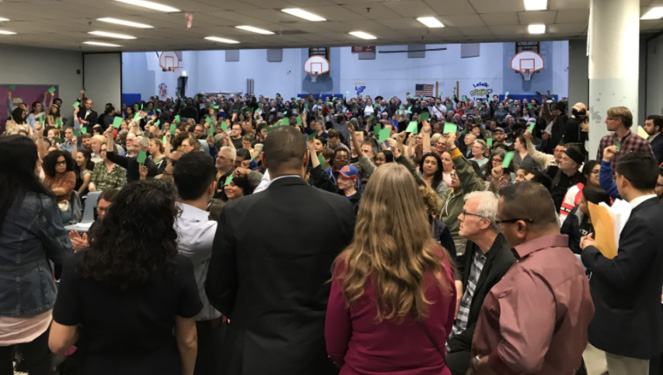Exploring zoning-related public engagement | Part 2/2
Designing equitable meetings

Photo: Local Progress
MPC and the Urban Institute are conducting research on how zoning and land use impact Chicago’s neighborhoods and residents from an equity, sustainability, and public health perspective. During the research process, we will be sharing what we learn and why it matters through a blog series. This blog is the third one and discusses some best practices in incorporating equity into public meetings.
To find out more about this project and stay up to date on progress check out our webpage.
How does equity fit into the public meeting process for zoning?
Over the past year, MPC and Urban Institute brought together partners from different sectors across Chicago—from city government to community organizations to the private sector—to share perspectives on the zoning process. One challenge that stood out: many partners felt the zoning process lacked opportunities for meaningful community input.
As we explored in our last blog post, public meetings and community meetings form a central part of the zoning process. They are also a key piece of the equity puzzle – equity is one of the assessment’s three pillars, alongside public health and sustainability.
EQUITY: “Outcomes and processes that result in fair and just access to opportunities and resources by way of repairing past harms and transforming power dynamics so that everyone, but particularly oppressed groups, both historically and presently, have the power and resources that they need to thrive.”
– Definition developed by Zoning and Land Use Assessment Steering
If meetings take public input seriously, they offer a chance for residents to proactively shape how a neighborhood changes. At the same time, relying on a self-selecting group to provide feedback can allow a small, highly-resourced group to block changes that could benefit a much larger group—such as homeowners in affluent neighborhoods opposing new housing, exacerbating region-wide affordability challenges.
A scan of the research on equitable public engagement
Therefore, we wanted to take a step back and understand some key ingredients for increasing equity in public and community meeting spaces, with a focus on the zoning process. Our research scan pulled themes from toolkits, guides, reports, academic articles, and other sources. The themes, bolded below, are sorted into two categories around structuring engagement and implementing meetings.
Structuring engagement
To build an effective engagement process, the research emphasized the need for a substantive input opportunity. This means that the engagement happens early enough—and decision-makers have enough discretion—to meaningfully change the outcome. Rather than a one-time meeting, continuous engagement allows for an ongoing relationship between decision-makers and communities. This means building the capacity for engagement into the project from the beginning and incorporating iteration to collect feedback and improve on engagement strategies.
To set up public engagement for success, the research repeatedly raised participant recruitment as central, as it influences who attends the meeting and whether they are a representative group. (This is an important equity consideration, as a study from our Urban Institute research partners on public engagement patterns in Louisville showed that residents from higher-income and whiter neighborhoods tend to be more likely to be public speakers in rezoning hearings.) Integrating education and transparent communication shapes whether everyone involved is well-informed about the decision, its historical context, and its scope. And a successful public engagement process involves trust building, acknowledging prior relationships between decision-makers and communities, which may not have always been smooth.
No one-size-fits-all solutions:
Though having a cookie cutter template would be convenient, the sources we reviewed were clear that equitable public engagement is highly case-by-case. Equity can look differently in different contexts. Still, we hope this non-comprehensive set of themes is a starting point to building more equitable meeting spaces.
Implementing meetings
The sources in our research underscored the equity implications of meeting logistics: the meeting’s location and time of day can be the difference between a busy community
member showing up or skipping out. Likewise, understanding and reducing barriers to attending—by supporting attendees with transportation, childcare, translation, or compensation—can enable more robust and representative attendance.
Within the meeting itself, several sources in our scan pointed toward including a variety of input options to accommodate people with different comfort levels and communication styles. Selecting an empathic and enthusiastic facilitator who has knowledge of the local context can also open opportunities for a wider range of residents to engage. Finally, thorough record-keeping can help ensure transparency, keeping everyone informed.
For more detailed example considerations for each of these themes, see this MPC resource.
Where the assessment goes from here
In the second phase of the Land Use and Zoning Assessment, one of our goals is to continue to discover the nuances of engagement in Chicago’s zoning process. Stay tuned as we continue to think expansively about equity and public engagement, including how some of these best practices can be implemented.
This is the third blog in the All about Chicago zoning and land use blog series
Interested in reading more from this blog series?
- Exploring zoning-related public engagement | Part 1/2: Public and community meetings
- Data points: A deep dive into Chicago’s zoning map and major zoning changes in the last two decades
Sources
Bergstrom, Danielle et al, “The Community Engagement Guide for Sustainable Communities,” PolicyLink, 2012.
Clark, Jill, “Designing Public Participation: Managing Problem Settings and Social Equity,” Public Administration Review, November 2017.
Einstein, Katherine and Maxwell Palmer, “Representation in the Housing Process: Best Practices for Improving Racial Equity,” Massachusetts Coalition for Racial Equity in Housing via The Boston Foundation, June 2022.
Einstein, Katherine et al, “Still Muted: The Limited Participatory Democracy of Zoom Public Meetings,” Urban Affairs Review, February 2022.
Elevated Chicago. “Community Engagement Principles 2.0,” Duo, May 2023.
Griffin, Toni et al, “Detroit Works Long-Term Planning Project: Engagement Strategies for Blending Community and Technical Expertise,” Buildings, October 2014.
Lemar, Anika Singh Lemar and Vicki Been. “Assessing the Law’s Effects on Public Participation in Land Use Decisions,” Yale University, forthcoming 2023.
Lemar, Anika Singh, “Overparticipation: Designing Effective Land Use Public Processes,” Fordham Law Review, 2021.
Lo, Lydia and Yonah Freemark, “Influencers, Bias, and Equity in Rezoning Cases: An Evaluation of Developer-Initiated Zoning Changes in Louisville, Kentucky,” Urban Institute, November 2022.
Nelson, Julie and Lisa Brooks, “Racial Equity Toolkit: An Opportunity to Operationalize Equity,” Government Alliance on Race and Equity, December 2016.
Shriver Center on Poverty Law and Chicago Area Fair Housing Alliance, “Working Toward a Healed City: How Chicago Can Build Equitable Communities From the Ground Up,” Shriver Center on Poverty Law, September 2019.
Spivak, Jeffrey, “6 Tips for Inclusive Public Meetings,” Planning Magazine, March 2019.
The Working Group on Legal Frameworks for Public Participation, “Making Public Participation Legal,” National Civic League, October 2013.
